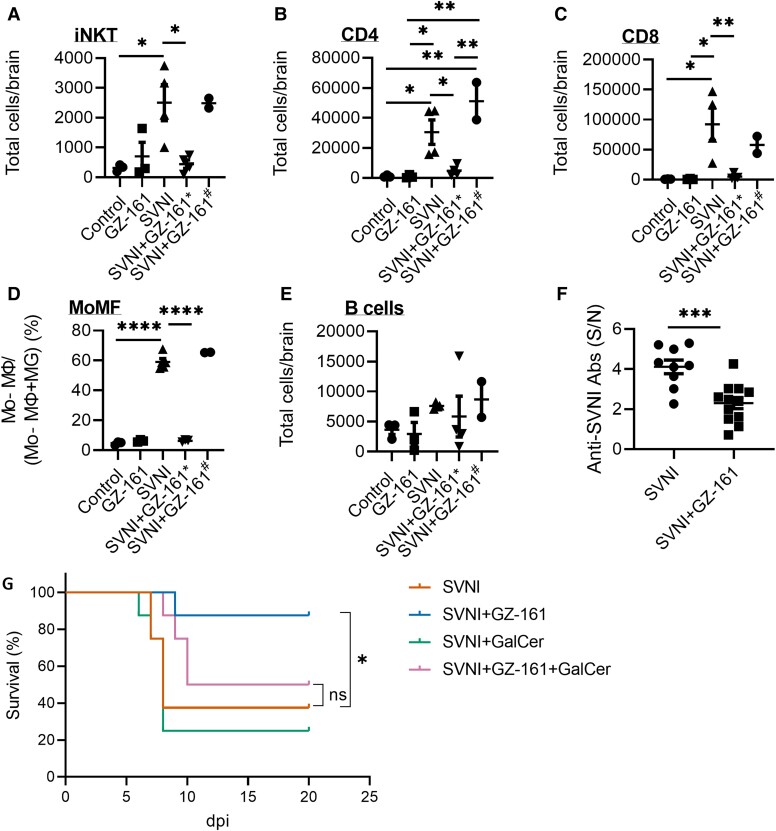Figure 4.
Treatment with GZ-161 decreases the number of immune cells in the brain after SVNI infection. (A–E) Flow cytometry analysis of iNKT, CD4 + and CD8+ T cells, monocyte-derived macrophages (Mo-MΦs), and B cells in the brains of control (n = 3, 1 female, 2 males), GZ-161 (n = 3, 1 female, 2 males), SVNI (n = 4, 2 females, 2 males), and SVNI + GZ-161 (n = 6, 3 females, 3 males) mice at 5 dpi. The SVNI + GZ-161 group was divided into two subgroups according to the weight loss experienced by the treated mice. Four mice did not show signs of disease at 5 dpi (SVNI + GZ-161*), and two mice lost weight (SVNI + GZ-161#). CD4+ T cells (CD45 + CD3ε+CD4+), CD8+ T cells (CD45 + CD3ε+CD8+), iNKT cells (CD45 + CD3ε+CD1d-PBS57+), B cells (CD45 + CD19+), Mo-MΦs (Ly6G−CD11bhi CD45hi), and microglia (MG) (Ly6G−CD11bhi CD45int). The percentage of Mo-MΦs within the total myeloid lineage cell population [Mo-MΦ/(Mo-MΦ +MG)] is shown. The data are presented as the total cell numbers per brain. The statistical analysis was performed by one-way ANOVA with Tukey’s post hoc test (α = 0.05). *P < 0.05; **P < 0.01; ****P < 0.0001. (F) Serum levels of anti-SVNI antibodies (total) in C57BL/6 mice left untreated (SVNI, n = 9, 4 females, 5 males) or treated with GZ-161 (20 mg/kg per day beginning on day 5 preinfection) (SVNI + GZ-161, n = 12, 6 females, 6 males) and infected with SVNI (15 PFUs, administered i.p.). Each data point represents the cell number in a single mouse brain. The anti-SVNI antibody levels were measured by ELISA at 5–6 dpi. The signal/noise (S/N) ratios in the SVNI and SVNI + GZ-161 groups were determined by dividing the mean absorbance of the test sera by the mean absorbance of the sera from control and GZ-161 mice, respectively. The results are presented as the means ± SEMs. The statistical analysis was performed using a two-tailed unpaired t test. ***P < 0.001. (G) α-GalCer abolished the therapeutic effect of GZ-161. Survival rate of C57BL/6 mice infected with SVNI (15 PFUs) at 21 days of age. The mice were not treated (SVNI), treated with GZ-161 (SVNI + GZ-161, 20 mg/kg per day, i.p.) starting from 13 days of age, treated with α-GalCer (SVNI + GalCer, 2 µg/mouse, twice at days 0 and 3 post infection, i.p.) or treated with both GZ-161 and α-GalCer. Comparisons of Kaplan–Meier survival curves by the log-rank test indicated a significant increase in the survival of the SVNI + GZ-161 mice compared with the SVNI mice. *P < 0.05 and no significant (ns) difference between SVNI and SVNI + GZ-161+ α-GalCer. n = 8 mice/group (4 females, 4 males).

